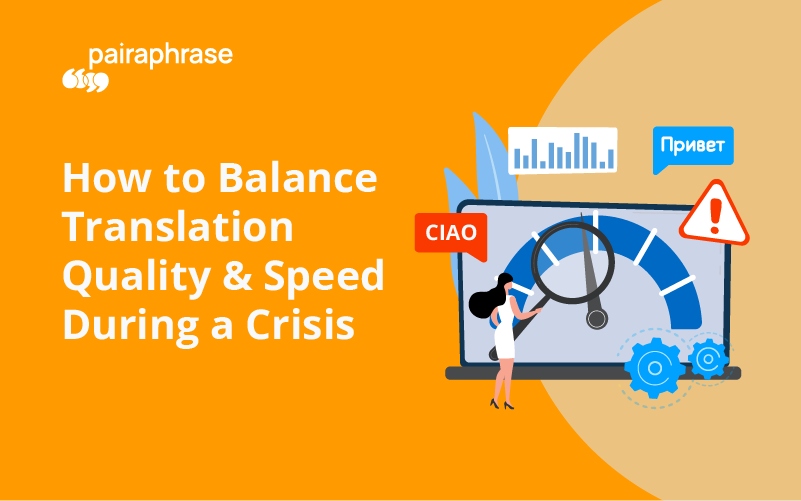Perhaps one of the most careful balancing acts for organizations during a crisis involves speed and quality. Especially when it comes to language translation.
For enterprises, the COVID-19 (Coronavirus) pandemic has been perhaps one of the most overwhelming times to try to send the right message to customers, patients, employees and stakeholders. The line between “getting it just right” and communicating “fast enough” can feel akin to walking a tight rope that’s on fire behind you.
Multilingual crisis communication can present a host of challenges to companies. That’s why we compiled the following 5 tips for making translation as speedy as possible without sacrificing quality.
These tips can also help you prepare for future crises.
5 Translation Speed & Quality Tips for Crisis Communication
1. Use Translation Software with Dynamic Machine Learning
Some crises are short-lived, and others carry on for longer than we can possibly predict. In the case of COVID-19, it’s difficult to say just how long.
During this time, systemic processes regularly experience overhaul in reaction to business disruptions and personal life as we know it. In many cases, we’re seeing AI implementations.
If your company is in the mindset of evaluating its global communication processes, you should consider adopting translation software with Dynamic Machine Learning.
How Does Dynamic Machine Learning Help During a Crisis?
Dynamic Machine Learning enables you to train your machine translation engine. The benefits you reap will include higher quality translations and significant time savings, which are key during a crisis.
In effect, you also benefit from lower costs associated with human-quality level translations.
This technology works wonders in conjunction with Translation Memory, which stores your post-edited translations for future automatic recall. More on Translation Memory below.
2. Commit Yourself (and Your Team) to Creating Translation Memories
The translation industry has come to rely on Translation Memory for storing human-quality level translations that can be recycled to produce more translations in the least amount of time possible.
However, you won’t benefit from Translation Memory if you don’t create Translation Memories. These are the post-edited translations your company saves to your Translation Memory.
The return on Translation Memory increases dramatically when you have more people creating them on your team.
We can only hope we won’t find ourselves in such a dreadful crisis again during our lifetimes. But if does happen again, Translation Memory (and Dynamic Machine Learning) will have you better prepared to deliver timely high-quality translations.
During COVID-19, you can even load your Translation Memory with bilingual glossaries related to the pandemic that have been cleaned, verified and organized by professionals.
3. Leverage a Powerful Translation API
API’s will help streamline updates to your data, especially within a rapidly changing environment such as a pandemic.
If your company connects its applications to each other in order to improve processes, you’ll want to use translation software that gives you access to a powerful translation API. After all, delivering raw machine translations to your other apps certainly isn’t going to save you time.
Unfortunately, this is the case with many translation API’s.
In contrast, a robust translation API will empower you to deliver dynamic high-quality translations from your Translation Memory in real-time across your applications and organization.
4. Use Automatic File Formatting
File layout and formatting consistency is of significant importance to many enterprises as it is. During a crisis, it becomes a bottleneck to delivering publishable documents that are rapidly demanded from all corners of the world.
The right translation management software will supply you with automatic file formatting. You can save hours and hours of work that you would normally spend reformatting a file. Font properties, images, spacing and breaks all remain intact.
5. Only Use Tools Optimized for Collaboration
Translation development is most often a collaborative process, especially during a crisis. But sometimes, more hands in the pot means extra time to delivery.
In order to enhance your team’s productivity, only use tools that are meant to save time for your entire team as you work together to produce translations. For instance, use translation software that makes it easy to avoid managing translations via spreadsheets and email.
What’s more, look for translation tracking, edit history, and a built-in instant messenger that organizes your communication by project.
Did You Find This Article Helpful?
Subscribe to the Pairaphrase YouTube channel for more translation resources.


.png)

.png)



